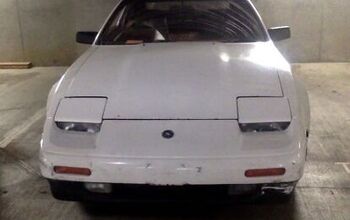Dealer Arbitration Screwing Up GM's Cadillac Dealership Strategy
GM’s newly-permanent Chairman/CEO Ed Whitacre balked visibly when asked following his self-coronation if the dealer cull arbitration process would hurt GM’s chances of success this year. “I’m not sure it will weaken us,” was his half-hearted response. Whitacre’s hesitation was a bit of a surprise, considering that GM is taking a far more tolerant attitude to the arbitration process than Chrysler. But, as Automotive News [sub] reveals, GM’s downsizing was highly focused on its Cadillac brand, and if arbitration results in widespread reinstatement, Cadillac could find itself stuck with a number of small-town dealers it doesn’t want.
A year ago, when Cadillac had 1,422 dealerships, GM announced that it would be cutting the brand to 500 dealers, bringing the sales network closer in line with its European competitors (Mercedes and BMW each have fewer than 400 dealers). The 900 Cadillac dealers cut in the dealership cull made up nearly half of all GM’s bankruptcy-era dealer shutdowns.
According to a lawyer representing culled dealers, GM cited “networking viability and throughput issues,”as the reason for closing most Cadillac dealers. “It means GM wanted to sell more cars through fewer dealers,” says Anthony Giardini, general counsel of the Committee to Restore Dealer Rights “It has nothing to do with performance. GM is saying we just don’t want to be in that market.”
That means the arbitration process might be more likely to find in favor of culled Cadillac dealers, saddling GM with rural dealerships for a brand that targets sales in coastal, urban communities. In contrast, non-Cadillac dealers were typically culled for more tangible reasons than the “networking viability and throughput” concerns, meaning they might be less likely to be reinstated.Thus, the central question of the arbitration process will be the validity of GM’s desire to migrate Cadillac retailers to urban areas. While GM leadership clearly feels that this is the path to competing on a more even footing with its European and Japanese competitors, dealers vehemently disagree. “The decision to have Cadillac abandon small-city and town markets where it dominated as a luxury brand to concentrate on large metros where it does not is the automotive equivalent of New Coke,” says one Virginia-based dealer.If arbitrators agree with sentiments like that, GM could be forced to rethink its entire retail strategy for Cadillac.More by Edward Niedermeyer
Latest Car Reviews
Read moreLatest Product Reviews
Read moreRecent Comments
- SCE to AUX All that lift makes for an easy rollover of your $70k truck.
- SCE to AUX My son cross-shopped the RAV4 and Model Y, then bought the Y. To their surprise, they hated the RAV4.
- SCE to AUX I'm already driving the cheap EV (19 Ioniq EV).$30k MSRP in late 2018, $23k after subsidy at lease (no tax hassle)$549/year insurance$40 in electricity to drive 1000 miles/month66k miles, no range lossAffordable 16" tiresVirtually no maintenance expensesHyundai (for example) has dramatically cut prices on their EVs, so you can get a 361-mile Ioniq 6 in the high 30s right now.But ask me if I'd go to the Subaru brand if one was affordable, and the answer is no.
- David Murilee Martin, These Toyota Vans were absolute garbage. As the labor even basic service cost 400% as much as servicing a VW Vanagon or American minivan. A skilled Toyota tech would take about 2.5 hours just to change the air cleaner. Also they also broke often, as they overheated and warped the engine and boiled the automatic transmission...
- Marcr My wife and I mostly work from home (or use public transit), the kid is grown, and we no longer do road trips of more than 150 miles or so. Our one car mostly gets used for local errands and the occasional airport pickup. The first non-Tesla, non-Mini, non-Fiat, non-Kia/Hyundai, non-GM (I do have my biases) small fun-to-drive hatchback EV with 200+ mile range, instrument display behind the wheel where it belongs and actual knobs for oft-used functions for under $35K will get our money. What we really want is a proper 21st century equivalent of the original Honda Civic. The Volvo EX30 is close and may end up being the compromise choice.


































Comments
Join the conversation
We lost our Cadillac store in Savannah, GA (metro area population about a quarter million). The next closest dealers are in Hilton Head, SC (about a 35 minute drive) and Statesboro, GA (about a 70 minute drive). Hilton Head isn't that terribly far, but that dealership never really tried to serve the Savannah market before. Also, Mercedes and BMW have stores both in Savannah and Hilton Head, so this idea that the goal is to have a dealer network like the Germans' doesn't seem to be what we are getting. And it looks like Caddy has pulled out of the city while BMW/Benz haven't. And GM wants to concentrate Caddy in urban areas as opposed to the sticks? Then why in the name of all that is good did GM keep a Caddy franchise in Vidalia, GA, a city with a whopping ten thousand people? Guess all those onion barons are good customers.
I can't really comment on the urban vs. rural thing, but I do remember that when I wasn't seeing very many big American sedans anymore on Washington and Oregon roads, a lot of them - not just Caddy of course, but Chrysler, Buick, Olds, Mercury - that I did see had midwestern plates. Maybe Caddy's strength became more coastal since then, but I don't think so.